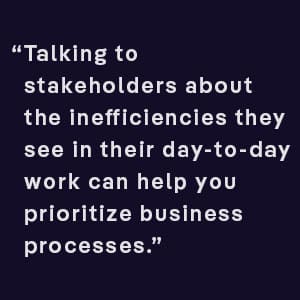These days, virtually all business teams embrace business process automation. Customer support teams have automated ticketing systems; HR teams have automated payroll and comp and benefits programs; finance departments automate their payment processes.
Yet, legal departments don’t always embrace automation and the benefits that that can bring. What is vital is getting stakeholder buy-in. This requires planning and gaining the trust of key stakeholders.
Stakeholders want assurances that digital transformation initiatives will:
- Not subject the organization to undue risk, liability, or litigation
- Have a human “safety net” factor, such as a contract manager, to address any anomalies identified by an automated review bot
- Not violate any business policies or regulatory compliance standards
- Create real value by increasing attorney efficiency, streamlining internal processes, and accelerating complex contract creation processes
- Replace high-volume — and often paper-driven — processes with automated tools
Suggested steps:
1. Communicate the Key Benefits of Automating Legal Processes
Gather all of your colleagues who may be affected or gained by the project and discuss the value and indeed risks of adopting legal process automation. And of course, in addition to the legal team, this can include sales, procurement, finance, and other departments who interact with legal and will also benefit.
- Ensuring the consistency and accuracy of legal documents, such as contracts, proposals, and external correspondence
- Increasing the everyday productivity of attorneys, compliance officers, and contract managers
- Making it more possible for corporate attorneys and contract officers to focus on higher-value, strategic work, instead of administrative document review
- Improving overall job satisfaction, which stems from the freedom to do really satisfying work
Of course, also talking to stakeholders about the inefficiencies they see in their day-to-day work can help you prioritize business processes.
2. Make Legal Automation Part of Organization-Wide Digital Transformation
Many companies have seen significant business digitization efforts already. If you include the integrated legal automation of strategic workflows — as part of the digital transformation project — legal team members will feel more included in the organization’s transformation journey.
Also, as you work to ensure buy-in of automation across departments, you can dispel any misconceptions from internal stakeholders, including executives from legal, IT, and other departments. All at the same time.
3. Dispel Myths About Automation
For every successful legal automation project, at least one has been derailed by naysayers and myth-spreaders (You know the kind). But a recent survey in the “In-House Legal Counsel’s Tech Buyers’ Guide” shows that general counsels (GCs) achieve an 80 percent satisfaction rate from the C-Suite on compliance matters, and 75 percent approval rates as trusted advisors when they are able to focus on more strategic legal work.
Here are just a few myths about automation that can — and should — be squashed:
Myth: Legal processes aren’t suited for automation; a legal professional needs to oversee every legal process and review.
Truth: Robotic process automation (RPA) involves programming rules and parameters within an algorithm, and a legal professional can participate in establishing those rules and parameters at the very beginning. If circumstances that a “bot” isn’t programmed for arising, a specified legal associate can then be alerted and decide how to handle anomalies.
Myth: Lawyers don’t know how to write RPA code. They’re far too busy with day-to-day responsibilities to learn how to use automation software.
Truth: Legal teams really don’t need to know how to code to automate legal use cases. ContractPodAi Cloud, for example, offers workflow builders to enable non-technical users to design processes — like approvals — without writing a single line of code. The online and mobile interfaces are very intuitive and easy to use, too.
Myth: Automation projects need cloud applications, and we can’t risk using a cloud-based application for our legal operations — it’s just not secure.
Truth: The cloud infrastructure behind corporate legal platforms like ContractPodAi Cloud is Microsoft Azure, which ranks among the most secure technology service providers in the world (In fact, legal documents are likely more secure on a cloud than they would be in an in-house data center).
At the end of the day, equipping your automation project team with this information will help you gain stakeholder buy-in. (It’ll also move legal automation upon your organization’s digital transformation agenda). By automating routine and repetitive tasks, like contract review and approval, you can change the way your organization feels about your legal and compliance teams. Instead of being viewed as “bottlenecks” in the day-to-day business, they can gain a reputation as being risk-aware enablers and leaders. Now, wouldn’t that be a welcome change?
See for yourself how ContractPodAi Cloud can automate your legal processes, and keep your organization moving forward in the digital age.
Author:

Sarvarth Misra
Connect with us on Linkedin





